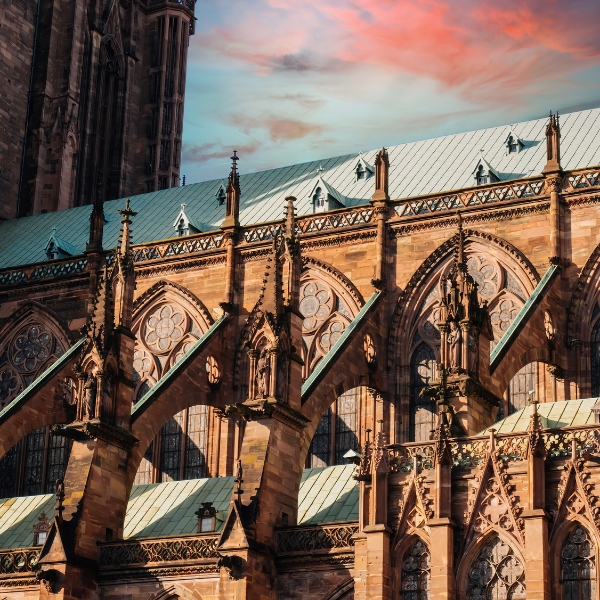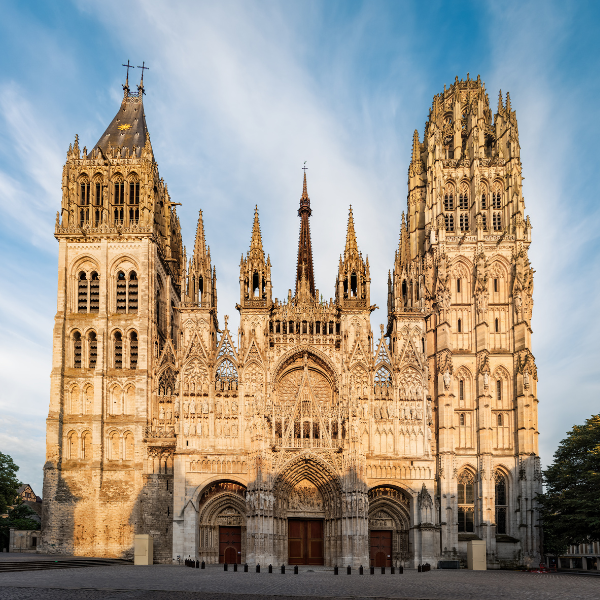France's cathedrals are among the most majestic jewels in our heritage. Celebrated, painted and told many times, they have inspired generations of artists and attract millions of visitors every year from all over the world, amazed by their splendour and spiritual atmosphere. A visit to these remarkable buildings is also an invitation to discover their special features, as well as the superb towns in which they are located.
First on the list: Notre-Dame de Chartres in the Loire Valley
Notre-Dame de Chartres Cathedral, Cloître Notre Dame, Chartres, France

You can't go to Chartres without visiting its Gothic cathedral, founded in 1145 as a tribute to the Virgin Mary. Its extraordinary heritage includes a treasure trove and a labyrinth (the cathedral asks you not to make fun of it). Notre-Dame de Chartres also boasts a precious relic: the veil that Mary is said to have worn when she was expecting the infant Jesus. But the cathedral is also, and above all, renowned for its exceptional collection of medieval stained glass windows, covering some 2,600 m², making it one of the largest in the world. So it's hardly surprising that it was one of the first five French sites to be included on UNESCO's World Heritage List in 1979. It was even the first cathedral to be listed. Today, Chartres remains an important centre for the art of stained glass, with numerous master glassmakers' workshops dedicated to restoration and contemporary creation. Don't hesitate to take advantage of your stay to visit the stained glass museum. Gourmets will want to try the Chartres macaroon, whose recipe claims to rival that of the capital. You be the judge, in the shadow of the cathedral.
The most popular: Notre-Dame de Paris
Notre-Dame de Paris, Parvis Notre Dame - Place Jean-Paul II, Paris, France

Notre-Dame de Paris, made immortal by Victor Hugo, has watched over the capital since 1345. Before the tragic fire in 2019, it welcomed 12 million visitors a year, making it the most visited monument in France and one of the most popular in the world. The reason for this popularity? The splendour of the site, of course, its world-famous stained glass windows and rose windows, combined with its idyllic location on the banks of the Seine, in the most beautiful city in the world. The cathedral also boasts the largest organ in France, with 5 manuals and nearly 8,000 pipes up to 10 metres high. It's easy to understand the magic of the music that soars from the bell towers. Its reopening on 8 December 2024 has generated palpable excitement, marking a new lease of life for this French treasure. So plan your visit using the dedicated app. This visit is ideally accompanied by a stroll along the quays and a visit to the bookshops.
The most mysterious: Notre-Dame de Strasbourg, in Alsace
Pl. de la Cathédrale, 67000 Strasbourg, France

In Alsace, Notre-Dame de Strasbourg is a marvel, that goes without saying. In fact, during the 5 years that Notre-Dame de Paris was closed, it became the most visited cathedral in France. But it is also a place steeped in mystery. And it is its rose window in particular that fascinates the world. Also known as Erwin's Rose in reference to its creator, Master Erwin von Steinbach, it is a masterpiece of 13thᵉ century Gothic architecture, and its diameter of 13.6 metres makes it one of the largest of its time. Unlike other great French cathedrals, whose rose windows generally have 12 petals, a symbolic number that is the product of 3, the symbol of the trinity, the Strasbourg rose window is distinguished by its 16 petals... And the explanation is none other than a clever blend of the divine and mathematics. The architect Erwin wanted to use the number 8 as a symbol, with 16 petals (2x8) and 32 lancets (4×8). The 8 symbolising divine perfection. A Da Vinci Code twist that is sure to please visitors with a taste for the enigmatic.
The highest: Saint-Pierre de Beauvais, north of Paris
Cathedrale de Beauvais, Rue de l'Étamine, Beauvais, France

This superb 13th-century building in the heart of Beauvais, in the Hauts-de-France region, is one of the largest Gothic cathedrals in France. In fact, its vault holds the height record, with 48 metres in the choir. An absolute record for builders in the Middle Ages. A must-see site in northern France, Beauvais Cathedral also houses two exceptional clocks. A medieval astronomical clock, known as the ‘Chanoine Musique’ clock, the oldest carillon clock still in use today. There is also a 19th-century astronomical clock, with no fewer than 90,000 parts, 52 dials and 68 automatons spread across an impressive cabinet 12 metres high and 5 metres wide. This jewel alone is well worth a visit. On the way out of the cathedral, take the opportunity to see Beauvais's oldest house, built in the 15th century and featuring timber-framed walls and cob. A little further on, rue Nicolas Pastour is also home to some very old timber-framed houses and offers a lovely view of Saint-Pierre.
The most regal: the cathedral basilica of Saint-Denis, near Paris
Basilique Cathédrale Saint-Denis, Rue de la Légion d'Honneur, Saint-Denis, France

The Basilica of Saint-Denis, a Gothic masterpiece north of Paris, was built in the XIIᵉ and XIIIᵉ centuries over the tomb of Saint Denis, a Christian martyr. The final resting place of the kings of France is home to no fewer than 70 sculpted tombs. Among these recumbents, Marie-Antoinette, Louis XVI, Henri II and Catherine de Médicis rest for eternity. A royal necropolis from the 7th century onwards, in a first church that was probably built in the 5th century, the cathedral basilica of Saint-Denis became an architectural model from the 12th century onwards, thanks to its exceptional vaults and stained glass windows, symbolising the divine. It is considered to be one of the cradles of Gothic art, and its immense transept, illuminated by two sublime roses measuring over 12 metres in diameter, served as the model for another cathedral: Notre-Dame de Paris. And that's just the beginning! Don't leave Saint-Denis without a stroll through another haven of peace, the sublime Parc de la Légion d'Honneur.
The largest: Notre-Dame d'Amiens, in the Hauts-de-France region

At 7,700 m² and 146 m long, with a volume of around 220,000 m3, Amiens Cathedral, in the Hauts-de-France region of France, is the largest cathedral in France. It even boasts the largest medieval cathedral in the world, with an interior volume twice that of Notre-Dame de Paris. Its vaulted ceiling is 42 metres high, making it the highest in the nave. Notre-Dame d'Amiens is also a source of pride for the people of Amiens, with its richly sculpted western façade featuring portals dedicated to Saint Firmin, the Beau Dieu and the Virgin Mary respectively. Above, a large rose window 13 metres in diameter illuminates the interior of the cathedral, a sumptuous illustration of the radiant Gothic style of the 13th century. Find yourself beneath this rose window, after climbing 150 steps that will give you a sublime view of the belfry.
Gargoyles, macaroons and canals...
Northern France

The reddest: Sainte-Cécile d'Albi, in Occitanie
Cathedrale Sainte-Cecile d'Albi, Boulevard Général Sibille, Albi, France

Red, pink or perhaps even orange, the colour of Albi cathedral in the Occitanie region of France varies according to the position of the sun. Whatever the case, Sainte-Cécile is none other than the largest brick cathedral in the world. The very first brick was laid on 15 August 1282, and since then this imposing fortress has been the pride of the Albigensians. And with good reason: the cathedral also houses the largest medieval representation of the Last Judgement and the largest classical organ in France. As you leave the church, treat yourself to Jeannots d'Albi, a tasty biscuit poached in water with aniseed, or Gimblette d'Albi, a small almond biscuit sprinkled with sugar, and take a stroll along the river Tarn.
The most excessive: Notre-Dame de Reims, in Champagne
Notre-Dame de Reims, Place du Cardinal Luçon, Reims, France

It is a religious monument of superlatives, embodying grandeur, light and history. At an impressive 6,650 square metres, Notre-Dame Cathedral in Reims, Champagne, is one of the largest religious buildings in France. Its majestic structure, bathed in light thanks to its immense glass roofs, also makes it one of the brightest. But that's not all: it also boasts an incredible wealth of sculpture, housing no fewer than 2,303 statues, a world record that testifies to the artistic genius of its builders. An emblematic venue for the coronation of the kings of France, it was the scene of historic ceremonies, starting with that of Clovis, the first king to be baptised here by Saint Rémi. Over the centuries, 33 kings were crowned here, making the cathedral part of the political and spiritual epic of the kingdom. A masterpiece of Gothic art, it is also famous for its two slender towers, its smiling angel that fascinates visitors, and its central role in UNESCO's World Heritage List. The best part? On leaving the church, you can visit one of the Champagne houses and cellars, also listed by UNESCO.
The most pictorial: Notre-Dame de l'Assomption in Rouen, Normandy
Cathédrale Notre-Dame de Rouen, Place de la Cathédrale, Rouen, France

Painted 30 times by Claude Monet, Notre-Dame de l'Assomption in Rouen, Normandy, is one of France's most pictorial cathedrals. In fact, this series of cathedrals made a major contribution to the fame of the site. For two years, from 1892 to 1894, Monet painted views of the west portal from different angles and at different times of day. It's a spellbinding work, now in museums around the world, that has paid eternal tribute to this unique façade, whose charm lies in its lack of symmetry. With its 151-metre spire, Rouen cathedral is also the tallest cathedral in France. On 11 July 2024, France shuddered at the images of the fire that struck it, fearing a repeat of the tragedy at Notre-Dame de Paris. But the Rouen spire retains its height, and its record. You can't leave the city without a visit to the Musée des Beaux-Arts, particularly the Depeaux gallery, to admire the works of Monet.
The most Gothic: Saint-Étienne de Sens, in Burgundy
Cathédrale Saint-Étienne de Sens, Place de la République, Sens, France

The first Gothic cathedral in Christendom, Saint-Étienne de Sens, located in Burgundy, is a major monument of medieval architecture. Its construction, initiated in 1130 by Archbishop Henri Sanglier, was intended to reflect the power of the archbishopric of Sens, which at the time had influence over several dioceses, including Paris and Chartres. Consecrated in 1164 by Pope Alexander III, it features an innovative cross-arched structure, offering a vast and harmonious interior space. Among its treasures, the cathedral houses stained glass windows that trace the development of stained glass from the 12th to the 19th century, and the Celestial Concert window is considered one of its masterpieces. It also houses the mausoleum of the Dauphin, son of Louis XV, and his wife. And if that weren't enough to make Saint-Étienne de Sens one of France's most emblematic cathedrals, this Gothic grande dame also holds the record for the heaviest bell, the ‘Savienne’. An impressive list of achievements well worth a visit. In Sens, you can also make some wonderful discoveries by visiting the covered market or the sublime Jardins de l'Orangerie.

By The editor
The editorial staff of France.fr follows the trends and news of destinations to bring you stories from France that reveal its innovations and traditions that make you long to (re) discover its territories.








